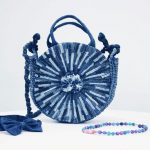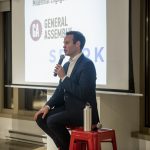In the intimate space of the restaurant-bookstore combo of Tres Gatos, restaurant-goers wandered to the colorful portraits hung on the walls. In each photo, one of five individuals posed within the space of their home. Each photographed person identified as non-binary.
Leah Eve Corbett captured the portraits to address rising stereotypes about the non-binary community stemming from the societal desire to categorize. They called the work “Nonbinary.”
Corbett worked with Tres Gatos’ artwork curator, Noah O’Leary, to bring their work to the restaurant. Last Thursday, Tres Gatos opened the exhibition, and it will remain up until the end of January.
Corbett graduated from Northeastern University last year, and they pursued this idea for their senior project. Corbett found five non-binary individuals through Facebook.
They said a major objective for the project included showing the multidimensionality of these people. Corbett spent a weekend at each person’s house to get to know the individual and to capture their different sides.
“[Staying] in a space where they were truly them all the time, exploring their home … the little things that make them who they are … adds a lot to the way we decide to compose the shots,” Corbett said. “It’s a collaborative effort, and that’s what really helps to make it more dynamic.”
Corbett said they felt inspired to create this project after working with a fashion photographer in New York City. They said they felt frustration at the lack of representation of non-white, cisgender models in the industry.
“It felt like everyone was being boxed in,” Corbett said. “I wanted to explore my own gender by photographing other people in a performative fashion way because that’s not something I typically did with my own photography.”
In addition to Corbett’s weekend-long residencies with their subjects, they are also selling zines written by the five individuals in Tres Gatos’ bookstore. Corbett said they hope that through these, people can further learn about the individuals through their voices.
The first individual Corbett photographed, Valeria, took on many titles. According to Corbett, Valeria identifies as brujx, a gender neutral variant of bruja, witch in Spanish, and is a painter and a blogger. Corbett said they connected, and specifically recalled when Valeria made a special tea to help them with their creativity.
“Being in their space and having them create all this healing energy and creative energy, I felt it,” Corbett said. “We really connected.”
From their efforts to represent the multidimensionality of the non-binary community, Corbett said they hope to fight stereotypes. They said they feel that non-binary people are often being represented as white and masculine.
Although installing “Nonbinary” in a restaurant had challenges regarding layout and space, Corbett said they enjoyed the setting because people who may not have come to see the exhibition could dine at the restaurant and view the photos.
“For the everyday person who maybe doesn’t know that much about non-binary and trans identity, they’ll be able to dine, experience these strong portraits and question gender itself,” Corbett said. “[And] maybe be interested in learning more about non-binary and trans identity.”
O’Leary, Tres Gatos’ curator, said he believed Corbett’s project would work well at the restaurant because the crowd would find the content interesting.
“The content of Leah’s work being all about showing the vast range of non-binary identities was really appealing to me, and I think that the crowd at Tres Gatos can appreciate and be interested in that,” O’Leary said.
O’Leary discovered Corbett’s work after sending out a call to artists on the Queer Exchange Boston Facebook group for the exhibition at Tres Gatos. O’Leary said he feels the work has already been a success and those who attended the opening night gave positive feedback.
“I felt that the general patronage was really excited about the work,” O’Leary said. “Even when we were still installing the show, two people walked in to get brunch, and one of them was like, ‘Wow, I love this, can I get your card?’ and we hadn’t finished setting up the show yet.”
Lee Zenkin, 20 of Framingham, attended the opening and viewed the work as a glimpse into what it’s like to be non-binary. They said the exhibition was important to counter the stereotypes Corbett noticed.
“[There] are many ways to express being non-binary,” Zenkin said. “[There’s] an androgynous or vaguely masculine association with non-binary people, which isn’t accurate. To show the spectrum of gender expression when it comes to non-binary people is important.”
O’Leary said his desire is for the exhibition to open people’s minds.
“I hope that people walk away with a little more insight into what non-binary gender identity can look like and can feel like,” O’Leary said. “In the trans queer community, … we’re very scrutinized for how we look, but these photographs have really strong feelings in them, and you can see it.”














